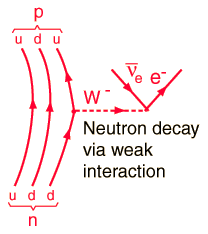
A single Neutron Decay
A free neutron will decay with a half-life of about 10.3 minutes but it is stable if combined into a nucleus. This decay is an example of beta decay with the emission of an electron and an electron antineutrino. The decay of the neutron involves the weak interaction (image at the right):
The Dineutron Decay
"The newly discovered dineutron decay mode joins the 15 other known forms of atomic decay, including double proton emission, double beta decay and double positron emission. The results hold promise to strengthen scientists’ understanding of the strong force that holds nuclei together and the processes taking place within neutron stars."
in rdmag.com
The experiment revealed a brand new form of nuclear decay, the process by which unstable atoms release energy and transform into more stable forms. But instead of emitting known patterns of radiation, the nucleus ejected two correlated neutronssimultaneously – a dineutron. Though physicists had long theorized about the existence of this form of decay, this was the first experiment to see the dineutron event in action.“We have for the first time unambiguously observed dineutron decay and clearly identified it in beryllium-16,” said Artemis Spyrou, professor of nuclear physics.
More in PhysOrg


No comments:
Post a Comment